Mental
Islington had been chosen for several reasons - the local population was a stable one, the economic level was moderate, social services were well organised and coordinated, and the transport facilities were good, enabling people to reach the Clinic easily from most parts of London.
The Child Guidance Council and the LCC had initially approached the Commonwealth Fund, an American organisation which not only founded child guidance clinics but was also their chief funder. The Fund agreed to provide financial support for the first five years.
The Clinic was one of the earliest child psychiatry units in England (the first had been the East London Child Guidance Clinic). It also became the main centre in the United Kingdom for training in child guidance. Its first Medical Director was Dr William Moodie, who had visited such clinics in the United States in 1927 with a view to establishing one in England.
Whilst there was no stated age limit, the majority of children were between the ages of 11 and 12. Their characteristic problems included backwardness, stealing, nervousness, being difficult and unmanageable, lying, having a temper, enuresis, sex difficulties, speech difficulties (stammering), truancy, spitefulness, defiance, nervousness, night terrors and fears, restlessness and sleeplessness, screaming, depression, nervous movements, anxiety, fits, feeding difficulties, unwillingness to attend school, lack of concentration, hysteria and overactivity.
About a third were referred by LCC schools and almost as many by their parents or guardians. Other referrals came from physicians, magistrates and probation officers. No child was accepted for treatment without the express agreement of the parents or guardians.
Physical disease was conspicuously absent, although some children suffered from fatigue and malnutrition due to poor housing conditions and poverty. Faulty posture and muscular flaccidity were common. In nearly all cases, home and local environment played a part in the causation of problems.
The history of each case was considered in detail. Treatment was very simple - talks, discussions, play (in groups or individually) and games. Mostly it took the form merely of advice to the parents and sometimes practical help to enable the advice to be carried out. If physical treatment was needed, the child would be referred to a doctor or a hospital. Educational problems were resolved with the help of the child's teacher. Sometimes a child was given individual tuition at the Clinic.
In 1930 two Fellowships in Psychiatry and two in Psychology were established for postgraduate training at the Clinic.
Early in 1931 Play Groups were instituted under the supervision of a psychologist, to help the children in their social adjustment. A speech training class was established for those children who stammered or had other speech difficulties. Throughout the year 23 cases were treated, in many cases with beneficial results.
By 1934 the Clinic had dealt with nearly 1,900 cases, referred from all over the United Kingdom - 973 children were seen during the years 1932 and 1933.
However, by 1935, financial backing from the Commonwealth Fund was gradually withdrawn (it finally ceased in 1939). The Clinic thus had to find other means of support and various society fund-raising events began to take place in the late 1930s.
At the outbreak of WW2 in 1939 the Clinic was evacuated to Oxford.
Present status (December 2017)
During WW2 (1939-1945) psychiatric social workers who had trained at the Clinic distinguished themselves in providing psychological counselling to servicemen and their families. Partly because of this, the National Education Act, 1944, mandated the establishment of such clinics throughout the U.K. In that year 95 child guidance clinics were established.
At the end of the war the Clinic returned to London, leasing No. 6 Osnaburgh Street, next door to St Saviour's Hospital. It joined the NHS under the control of the Central Middlesex Hospital Management Committee, part of the North West Metropolitan Regional Health Board, who renamed it the Child Guidance Training Centre.
During the early 1960s the Training Centre moved to No. 33 Daleham Gardens in Hampstead.
In 1967 it moved once more, to the newly opened Tavistock Centre in Swiss Cottage. It carried on as a separate entity in a wing away from the Tavistock Centre's Department for Children and Parents until 1985, when both merged to form the Child and Family Department.
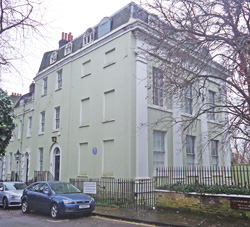
In 1950 No. 1 Canonbury Place was occupied by the Marquess of Northampton's London Estate Offices, as well as a housing association and a chartered surveyor. It was Grade II listed in 1954. Today it is an office building.
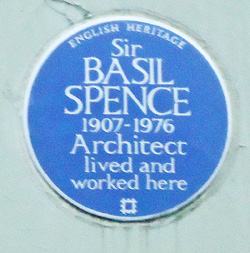
The architect Sir Basil Spence acquired the building in 1956 for use as a residence and office.
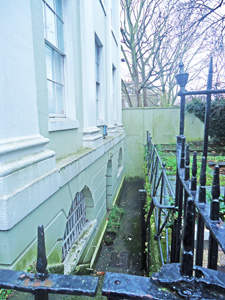
The basement clinics could be accessed by a stairway at the side of the house.
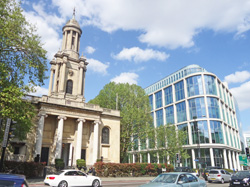
At the end of WW2 the Clinic moved to No. 6 Osnaburgh Street, a building which later became the Dispensaire Francais until 2005. Osnaburgh Street has been completely redeveloped and is now part of Regent's Place, a 13-acre office, retail and residential development.
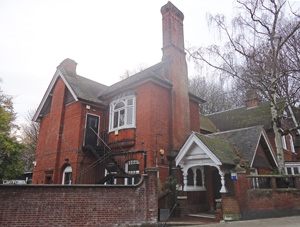
In the early 1960s the Training Centre moved to No. 33 Daleham Gardens (above and below) before moving to the Tavistock Centre. The building is currently the Tavistock Children's Day Unit.
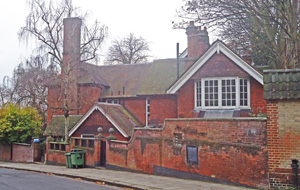
(Author unstated) 1932 London Child Guidance Clinic. Report for the period July 29th, 1929 to December 31st, 1931. London, self-published.
(Author unstated) 1960 Obituary. William Moodie. British Medical Journal 1 (5187), 1742.
Davies HA 2010 The Use of Psychoanalytic Concepts in Therapy with Families: For all Professionals Working with Families. London, Karnac.
Fox E 1927 The Child Guidance Council and the Commonwealth Fund. Mental Welfare 8, 79-80.
Hendrick H 1994 Child Welfare: England 1872-1989. London, Routledge.
Horne A, Lanyado M (eds) 2015 An Independent Mind. The Collected Papers of Juliet Hopkins. London, Routledge.
Moodie W 1935 The London Child Guidance Clinic. A Survey. London, self-published.
Smith BC 1929 Correspondence. London Child Guidance Clinic. Journal of the American Medical Association 92, 1372.
Smuts AB 2008 Science in the Service of Children, 1893-1935. New Haven, Yale University Press.
Wooldridge A 1994 Measuring the Mind: Education and Psychology in England c. 1890-1990. Cambridge University Press.
http://genome.ch.bbc.co.uk
http://studymore.org.uk
https://warwick.ac.uk
https://wellcomelibrary.org
www.british-history.ac.uk
www.dailymail.co.uk
www.educationengland.org.uk
www.philanthropyroundtable.org
www.starcourse.org
www.yumpu.com
Return to home page